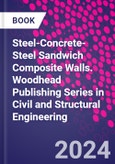Steel-Concrete-Steel Sandwich Composite Walls covers key aspects of steel-concrete-steel sandwich composite walls, including: an analysis and design and their loading carrying capacities when subjected to different loading scenarios, e.g., bending, shear, punching, compression, in-plane and out-of-plane shear, etc.; analyzes the basic resistance of the steel-concrete-steel walls; and covers the use of such structures under particular seismic conditions. Such structures combine the advantages of steel and reinforced concrete structures with wide advantages, e.g., it permits prefabrication, increases the construction efficiency, shortens construction period, saves formwork and manpower, and provides high resistance to blast and impact loads.
Steel-concrete-steel sandwich composite walls, as a representative structural element of steel-concrete-steel sandwich structures, have been used as the nuclear shielding walls in the new generation nuclear power plant, shield tunnels in Japan, immersed tunnels, ice-resisting walls for Arctic offshore platforms, shear walls in high-rise buildings.
Please Note: This is an On Demand product, delivery may take up to 11 working days after payment has been received.
Table of Contents
1. Introduction2. Developments of connections for steel-concrete-steel sandwich walls
3. Shear behaviours of Enhanced C-channel connectors in SCS sandwich walls
4. Compression behaviours of SCS sandwich walls
5. Behaviours of SCS sandwich walls under out-of-plane bending and shear
6. Punching shear behaviours of SCS sandwich walls
7. Seismic behaviours of SCS sandwich walls under lateral cyclic loads
8. Seismic behaviours of SCS sandwich core walls under lateral biaxial cyclic loadsReferences








